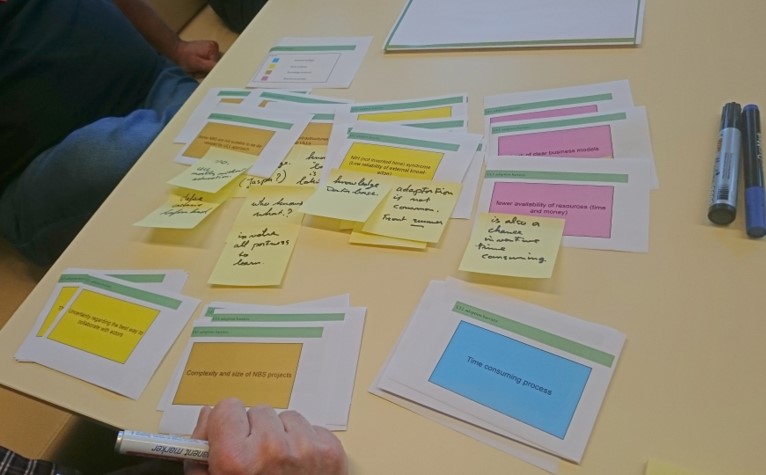
Co-creating nature-based solutions: barriers to adoption in the city of Eindhoven
- Wed, 29/01/2020
In October last year, the Technical University of Eindhoven and Eindhoven Municipality arranged a workshop to identify barriers to the adoption of an urban living lab concept for the implementation of nature-based solutions (NBS). Many actors from different organisations and institutional levels are involved in this implementation process. Our aim for this workshop was to find specific issues which keep those actors from collaborating with each other: what keeps them from learning together and from learning from each other’s experiments and experiences during the course of the projects. Participants from various departments of the municipality, the Waterboard, Province Noord Brabant and ‘Trefpunt Groen Eindhoven’ joined the workshop. They are all members of the ‘Community of Practice’, which was the result of a series of co-creation workshops in the spring of 2018. This group now meets several times a year to share their knowledge and experiences of NBS.
To better understand the aim of the workshop, let’s start by taking a quick look at the background. Nature-based solutions as an innovative approach to address societal challenges separates itself from previous similar approaches by emphasising the role of co-creation and collaboration among actors, to develop these solutions and to realise their multiple benefits. Urban living labs (ULLs) are used as a concept and tool to provide a structure for this. They also help to define the actors that should be involved and how they can work together to reach their common goals.
In general, ULLs have three characteristics. Firstly, they are located in and deal with the real urban context issues. Secondly, co-creation and participation is an inseparable part of them. Thirdly, they are designed to experiment with solutions, to evaluate them and to learn from those experiences. However, realising all these characteristics in practice is not so straight forward and there are many barriers in between which should be addressed.
As a results of the workshop, the most critical barriers identfied for co-creating NBS in Eindhoven, using the living lab method, are the following:
- Institutional fragmentation and sectoral silos. Different department’s work based on their own legal and policy frameworks, which makes it incompatible with the multidisciplinarity of NBS projects.
- A lack of public awareness, engagement and support. Multiple benefits of NBS can best be delivered when the public interest is incorporated into the planning and design of the solutions.
- Limited access to information regarding the functionality and performance of these solutions. In order to motivate citizens to engage in the NBS development process, they should have access to information about and they need to be able to recognise the benefits of these projects for them and how the NBS will affect their daily life. The use of visualisation tools can be useful for this purpose.
- A lack of clear and effective methods to include different groups of people from different age, income, and gender groups into the planning process. A possible solution to address this barrier, which was emphasised during the workshop, was to include different citizen groups from the early stages of the planning process and to dedicate more resources (financial and human) to it.
- A lack of sufficient evidence and lack of mechanisms to share the experiences effectively. In order to facilitate the upscaling of NBS, it is important to identify what we want to learn from them. With that in mind, we have to put more emphasis on learning instead of focusing on evaluation. One solution could be to provide platforms for sharing information and experiences, for example in the form of pitches.
In conclusion, we realised through this workshop that in order to bring different stakeholders together to implement nature-based solutions, the uncerntainties regarding the functionality and performance of NBS should be addressed. Stakeholders need to understand their roles and the benefits of engaging in the development of these solutions. However, the role of mainstreaming NBS in higher level policy and legal frameworks is not negligible.
These outcomes is something the Community of Practice can keep in mind for their next meeting, and together try to reduce the number of identified barriers by, for example, initiating projects to better inform others about NBS. The Eindhoven University of Technology will use the results of the workshop to develop a structural model of barriers to the co-creation of NBS, to provide sensible policy recommendations to facilitate the implementation process.
Shahryar Ershad Sarabi, Eindhoven University of Technology
Mayke van Dinter, Municipality of Eindhoven